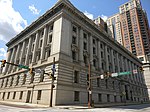300 East Pratt Street
300 East Pratt Street is a proposed skyscraper in Baltimore, Maryland. The building, originally expected to rise 640 feet (200 m), is current on hold due to high vacancy rates in the city. Construction of the building was to begin in 2007 and was originally expected to be completed in 2010. The construction of this building was proposed in 2003, though, it was never approved by the state of Maryland. In 2006, the construction of the building was again proposed, and finally approved by the state of Maryland. The building is being built where the Hearst Production Building once stood. Plans are now scaled back to 40 stories and 300,000 square feet of office space, in addition to a 270-room hotel. 300 East Pratt Street is located in Baltimore, MD between Commerce and South streets, housed the former Baltimore News-American building. It has been vacant and used for a parking lot for decades. However, parking lot owner InterPark LLC purchased the site in August 2013 after a redevelopment plan proposed by Urban America LP in 2006 fell apart during the recession. As of January 2022, MCB Real Estate LLC owns and is developing the property. No further plans or details have been provided at this time.
Excerpt from the Wikipedia article 300 East Pratt Street (License: CC BY-SA 3.0, Authors).300 East Pratt Street
East Pratt Street, Baltimore
Geographical coordinates (GPS) Address Nearby Places Show on map
Geographical coordinates (GPS)
| Latitude | Longitude |
|---|---|
| N 39.2866 ° | E -76.6109 ° |
Address
The Gallery at Harborplace
East Pratt Street 200
21202 Baltimore
Maryland, United States
Open on Google Maps










